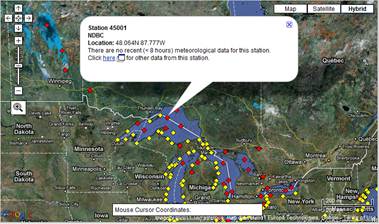

Name___________________________
Background
Large lakes respond to seasonal changes in solar radiation. In the summer lake water on the surface warms and becomes less dense than the water below creating layers (stratification), especially in deep lakes. These layers are clearly identified in a temperature profile (graph of temperatures at different depths) of the lake. The epilimnion is the warm water on the surface, the metalmnion is the layer where the temperature drops quickly, and the hypolimnion is the cold layer on the bottom. As the seasons change, so does the temperature of the water on the surface of the lake. In the fall when the surface water cools, begins to sink, and with the help of the wind this water mixes with the water below. The winter finds a uniformly cold lake with winds continually mixing the water. This mixing continues through the spring until stratification begins all over again with the warming of the lake.
As fascinating as this process is, it is equally important to the sustainability of the lake ecosystem. Marine life in these large lakes have adapted to the conditions of the lake where you may find stratification of species living in the different layers. An important concept tied to the success of the marine life in these lakes is the availability of oxygen in the lakes in all the layers. A concern has arisen from the lack of oxygen to the species surviving in the hypolimnion. Our large lakes are warming too much in the summer, thus prolonging the mixing which is necessary for the distribution of oxygen and nutrients throughout the lake. When these summer thermal layers persist at the surface, they contribute to the formation of "dead zones," areas of the lake devoid of any life. This does not happen much in lakes with deep hypolimnions, but can be an issue in lakes with shallow hypolimnions. These lakes that have "dead zones" in the summer are called eutrophic. In this lesson you will explore a number of temperature profiles from Lake Superior to identify the layers and to identify when mixing has occurred.

Materials
Lake Superior Temperature Profiles from Station 45001
Part I
1. Write a hypothesis for what you think will happen when the 2 jars are stacked. Explain your reasoning.
2. List and explain your observations of what occurred in the stacked jars. Draw a model of the 2 jars labeling the epilimnion, metalimnion, and hypolimnion.
3. Record additional observations of the stacked jars after 10 minutes. Explain what is happening.
4. Write a statement that summarizes the demonstration.
5. Apply this demonstration to lake stratification.
Part II
1. Look closely at the temperature profiles for a station in Lake Superior, and answer the questions below.
What are the variable and the unit on the horizontal axis? ________________________
What are the variable and the unit on the vertical axis? ___________________________
Is the surface of the water at the top of the graph or bottom of the graph? _______________
2. Look at the profile for each month and identify the surface temperature and the bottom temperature. Also, determine if the lake water at this station is stratified. Place all your responses in the table below.
|
Month |
Surface Temperature (°C) |
Bottom Temperature (°C) |
Stratified (yes or no) |
|
January |
|
|
|
|
March |
|
|
|
|
May |
|
|
|
|
July |
|
|
|
|
September |
|
|
|
|
November |
|
|
|
3. Look carefully at the shape of each profile. What is the main cause of the differences in the profiles?
4. For each profile, place an "X" in the box if the thermal layer is present, and leave the box empty if it is not. Label each of these layers on the profiles if they are present.
|
Month |
Epilimnion |
Metalimnion |
Hypolimnion |
|
January |
|
|
|
|
March |
|
|
|
|
May |
|
|
|
|
July |
|
|
|
|
September |
|
|
|
|
November |
|
|
|
5. During which time period has turnover occurred?
How do you know?
What is your evidence from the profiles?
6. In addition to time of year, what variables affect stratification in lakes?
7. What is a lake "Dead Zone?"
What causes dead zones?
In which layer are dead zones found? ________________________ Why?
What time of year do dead zones form? ______________________ Why?
What are effects of dead zones on the organisms living in the lake?
8. Identify a profile where a "dead zone" may occur. ____________________
Why did you select that profile?
What additional information (or data) do you need to confirm your choice?
9. Use reference materials to research the oxygen requirements of various marine species living in lakes, and share your results with your classmates.